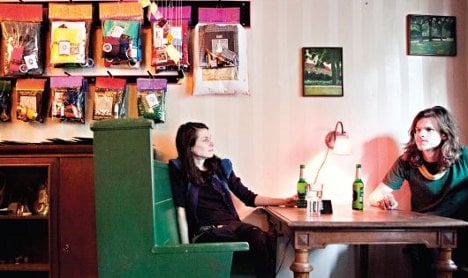Heroic multicafé
Quirky Mary Ocher, disco-synther Miss le Bomb and new wavers Trike! have all taken to the little stage in the back. The walls are covered with monthly-rotating works by local artists, and a whiff of freshly made coffee blends with the sharp scent of goat cheese from the quiches baked on site. Neukölln café-of-all-trades Heroes is a little bit of everything. French-American owner Caroline Burnett originally wanted to open up a full-fledged music venue, but since opening in 2009, Heroes has evolved into a sort of melting pot of food, music, films, books and art, housing a weekly film night (Tuesdays at 9 pm, always in OV and following a monthly theme) that moves outdoors in the summer. It’s a place where the back room is known to play host to an impromptu poetry session, a dance party or an exhibition. And it’s all accompanied by food deriving from Burnett’s dual national origin: French and American-style Sunday brunches (from €3.50), quiches and crêpes in various varieties, all of which can always be washed down with a €2.10 Picon bière (beer + orange liqueur – it’s a French thing). Everything is wrapped up in Ziggy Stardust-esque stripes, painted playfully across the walls of the front room, paying colourful tribute to Mr. Bowie, who’s also the inspiration for the place’s name (taken from his 1977 Berlin-trilogy album). The décor – which includes items like a dummy torso and a birdcage left behind by a friend who decamped to Switzerland – is as schizophrenic as the cultural offerings – but all in the usual playful-eclectic Berlin way. Don’t miss the sonic summer fun when Heroes helps turns Friedelstraße into a outdoor fest on June 21 at Fête de la Musique. A full programme can be found on www.heroesberlin.com or www.48-stunden-neukoelln.de.
HEROES | Friedelstr. 49, Neukölln, U-Bhf Hermannplatz, Tue-Sun 12-20 (or later when there are events)
Venture communism
A spectre is haunting Prenzlauer Berg designer clothing outlets: communism. Schivelbeiner is small and stays stays open for barely half the week, but what it lacks in size and availability, it makes up for in revolutionary ambition. For it’s not only a slightly anaemic mixture of Kneipe and Teehaus; Schivelbeiner is also the new retail home of the world’s first apparently-socialist designer clothing brand, OCA. The founders, Lisa and Iain Ross (from Bavaria and Scotland, respectively), wouldn’t really fit in with the crust punks one normally associates with leftist activism in Berlin – they are soft-spoken and polite, conservatively dressed. They opened Schivelbeiner in May after six months of painting, sewing and fomenting. Lisa’s hand-painted faux-wallpaper patterns march rigidly across the wall until suddenly dissolving into noodly civil war near the back corners. In what might be called the “Teach-A- Man-To-Fish Business Plan,” Lisa and Iain are selling kits, not clothes. With OCA, Lisa and Iain intend to smash the branded establishment and encourage consumers to seize the means of production. The kits sell for the (decidedly un-proletariat-friendly) sum of around €100 and come with everything you need to make your own garment: fabric, needles, thread, plan and even a label tag certifying its authenticity. More adventurous/broke comrades can opt to buy the plans without the materials for around €15, and shameless bourgeois pigs can buy the finished clothing with price tags ranging upwards of €300. If you’re politically confused, well, you can just have a Beck’s.
OCA IM SCHIVELBEINER | Schivelbeiner Str. 7, Prenzlauer Berg, U-Bhf Schönhauser Allee, Sun-Wed 11-22
On the Czechlist
Roman Kratochvila, the soft-spoken Czech that owns Shakespeare & Sons, Berlin’s brand new English language bookstore, seems oddly noncommittal about his new Prenzlauer Berg home. “I was told here or Kreuzberg,” he says. Some benevolent wind guided him, together with his business partner Radin and wife Laurel, when they parachuted in from Prague last month, seemingly with nothing more than the shirts on their backs and the business experience that comes from 10 years of running Prague’s most successful English-language bookstore. Shakespeare & Sons is your inner-bookworm’s paradise and a perfect fit for the Helmholtzkiez: Sunlight shines through the big, street-facing windows onto houseplants in cute porcelain tubs and rows of lineographed dust jackets. By now you’re thinking, “Finally I can buy a graphic novel and satisfy my curiosity about home cheese-making in the same place,” but it’s more than that. The plan is to stock one-third used, two-thirds new English-language books, as well as a small French section and an extensive selection of children’s books. Penguin Classics reissues and basically anything with muted blues or a bird on the cover line the walls (including a comic section that holds a Prenzlauer Berg graphic novel!), and there are a few comfortable armchairs tucked into the corners, their upholstery matched to the green-stained hardwood floors. The proximity of the venerable and respected St. George’s, a mere two blocks south, would be daunting to most aspiring booksellers. But judging by the crowd of multilingual Prenzlauer Berger swarming in the street outside, there’s more than enough demand to go around. Tip: Prices are based on current exchange rates, so books imported from America will save you some money.
SHAKESPEARE & SONS | Raumerstr. 36, Prenzlauer Berg, S-Bhf Prenzlauer Allee
Bubble trouble
At BoboQ, Berlin’s first dedicated bubble tea house, the crowd is loud, numerous and principally Asian, a good sign one might think. Done well, bubble tea – the Taiwanese iced tea typically made with balls of tapioca, milk and flavouring – can be the perfect summer drink. Unfortunately, the slimy texture of the tapioca and the artificial, overly sweet taste spoils the fun. To get a good version of the drink, book a flight to Taipei – or at least Los Angeles. Drinks range from €2.80 to €3.50.
BOBOQ | Marburger Str. 17, Charlottenburg, U-Bhf Wittenbergplatz



 Please whitelist us to continue reading.
Please whitelist us to continue reading.
Member comments